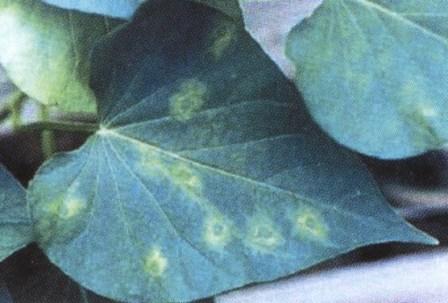|
|
Kingdom |
Virus |
|
Family |
Comoviridae |
|
Genus |
Nepovirus
(probable) |
Note: Its classification under the genus nepovirus
has not been fully confirmed and is still considered tentative.
Reported only
in a few countries in the Pacific and Africa. Crop losses are unknown.
SPRSV was isolated from cv. Wanmum from Papua New Guinea. It has also been
detected in plants from Kenya.
Sweetpotato plants infected with SPRSV may show chlorotic ring spots but in
most infected cultivars plants are symptomless. In graft-inoculated sweetpotato
cultivars Centennial and Rose Centennial, the virus induces extensive chlorotic
spotting of leaves.
The virus has isometric particles measuring 28 nm in diameter. It has
three components with sedimentation coefficients of 47, 87, and 130 S and
contains a single polypeptide of Mr 56 KD. The middle (87 S) and bottom
(130 S) component particles contain ssRNA of c. 6,670 and c. 8,448
nucleotides, respectively. It has a capsid polypeptide of Mr 56.5 KD. Although
the virus has some properties typical of nepovirus, it is serologically
unrelated to any of the 12 members of the nepovirus group.
The virus is transmitted by mechanical inoculation, but not by contact
between plants.
The only known natural host of SPRSV is Ipomoea batatas.
SPRSV can be experimentally induced to infect species in several (3-9)
families. The following species are susceptible: Capsicum annum, Chenopodium
amaranticolor, C. capitatum, C. murale, C. quinoa, Cucumis sativus, Datura
stramonium, Glycine max, Gomphrena globosa, Hibiscus esculentum, Ipomoea nil, I.
setosa, Nicotiana benthamiana, N. clevelandii, N. glutinosa, N. megalosiphon, N.
tabacum, Phaseolus vulgaris, Tetragonia expansa, and Vigna unguiculata.
Regulatory control
International exchange of virus-free germplasm.
Cultural control
Use of clean, healthy planting materials.
Brown, J.D., Brunt, A.A., and Hugo, S.A. 1988. Studies on
viruses isolated from sweetpotato (Ipomoea batatas). Report of the
Glasshouse Crops Research Institute for 1986-8: pp. 104-108.
Brunt, A.A. and Brown, J. 1988. The virus with filamentous
particles. In: International Working Group on Sweetpotato Viruses (IWGSPV),
Newsletter 1: 3.
Brunt, A.A., Crabtree, K., Dallwitz, M.J., Gibbs, A.J.,
Watson, L. and Zurcher, E.J. (eds.) (1996 onwards). `Plant Viruses Online:
Descriptions and Lists from the VIDE Database. Version: 20th August
1996.' URL
http://biology.anu.edu.au/Groups/MES/vide/
Brunt, A.A, Crabtree, K., and Gibbs, A. 1990. Viruses of
tropical plants. CAB INTERNATIONAL, UK, in association with Australian Centre
for International Agricultural Research.
Wambugu, F.M. 1991. In vitro and epidemiological studies of
sweetpotato (Ipomea batatas)(L.) Lam. virus diseases in Kenya. PhD
Thesis. University of Bath. 271 p.
Contributed
by: Segundo
Fuentes
and Luis Salazar |
Taxonomy
Economic
importance
Geographical
distribution
Symptoms
Morphology
Biology
and ecology
Host
range
Management
References

Chlorotic ring spots.
|

